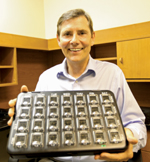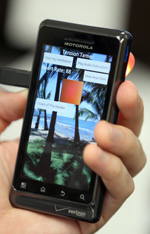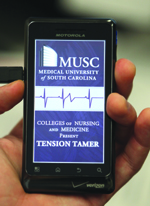|
By Dawn
Brazell
Public Relations
Given the
choice among an American,
Spanish or British accent on
their cellphones, the majority
of people pick British. The
reason Frank Treiber, Ph.D.,
knows this bit of trivia is
because he leads a group
dedicated to taking the latest
in mobile health care technology
and translating it into
evidence-based research projects
that capitalize on the strengths
of technology to connect health
providers and patients.
See How
It's Being Used
Innovative
meditation app called Tension
Tamer, Page 6.
Watch the video, http://tinyurl.com/6vd4fv6.
SMASH study to
combat high blood pressure, Page
6.
Watch the video, http://tinyurl.com/6m6dpp9.
Frank Treiber,
Ph.D., is used to catching the
latest wave, whether it's in the
Atlantic Ocean or in the use of
mobile technology that he sees as
a game changer in shaping the
delivery of health care.
 Dr. Frank Treiber
shows off the MedMinder, a
wireless, computerized medication
dispenser. Dr. Frank Treiber
shows off the MedMinder, a
wireless, computerized medication
dispenser.
Treiber,
formerly vice president for
research development at Georgia
Health Sciences University, came
to MUSC in 2010 as a SmartState
endowed chair in technology
applications to prevent and manage
disease. He leads the Technology
Center to Enhance Healthful
Lifestyles that is charged with
developing and commercializing
software and technological
products to improve the delivery
of health care.
The field of
mobile technology sort of chose
him rather than the other way
around, he said. His research
career previously had focused on
24-hour telemonitoring devices
that tracked patients' vital
signs, such as blood pressure and
heart rate, in their natural
environment.
"As I saw
technology developing, we started
morphing into smartphones and into
the management of diseases and
prevention work. MUSC had the
foresight along with USC to
develop a center of economic
excellence involving technology
applications."
The options for
mobile health care are limitless.
This is telemedicine, but it also
is about enabling patients to
better monitor their health, he
said. "We wanted to reach out to a
lot of people and what we have
found that one thing that a lot of
people have irrespective of their
socioeconomic status, their ethnic
background is a smartphone or
cellphone."
A recent proof of concept study
featured the app Tension Tamer.
Many chronic diseases are
stress-activated or worsened by
stress, such as high blood
pressure, cardiovascular disease
and Type II diabetes. Treiber said
the beauty of the Tension Tamer is
that it takes breathing awareness
meditation that is easy to learn
and has been shown to be effective
in lowering blood pressure and
puts it into an app that patients
can access easily anywhere. (See
story on page 6).
Researchers
figured out how to use the
smartphone camera to do pulse
readings while a person is doing
the meditation app so they can get
immediate physiologic feedback.
Based on study results with school
teachers, they found large
reductions in resting and
ambulatory blood pressures in
prehypertensive adults, he said.
Participants also reported a
reduction in stress and anxiety
and better ability to sleep.
The long-term
goal is to have an app available
on the android and Apple cellphone
markets.
"It'll be one
of the 16,000 apps that are out
there for health care or wellness,
but it will be one of the very few
that has been empirically
validated – that has been shown to
be very feasible, very usable and
acceptable to those who are using
it. The most important thing is
that they maintain it. They keep
doing it. We had high adherence
rates to this twice a day, 10
minute sessions for three months,
in part, because of the feedback
they're getting."
Another success
story is the pilot study called
SMASH, Smartphone Medication
Adherence Stops Hypertension,
which involved Hispanic adults
with uncontrolled high blood
pressure. (See story page 6.)
One of the
biggest problems that health care
providers face is getting patients
with chronic diseases to take
medications properly. Thirty to 50
percent of patients do not take
their medications as prescribed.
"It's not just people who are
elderly or on a large number of
medications, either. It turns out
this problem affects a wide range
of ages and patients."
With the SMASH
study, patients were given an
electronic medication tray with
individualized compartments for
each day's dosages. The patient
receives a series of alerts,
including a bright flashing light
at first followed by a loud chime
and an automated phone call if the
medication remains untaken. The
patients also received a blood
pressure monitor to take their
pressures every three days. The
readings are sent wirelessly to
their smartphone and sent via
internet to a secure computer.
Their doctors receive summary
reports of their patients'
pressures every two weeks and
alerts if pressures are ever in a
danger zone.
Initial results
from the three-month trial are
very promising, he said. Patients
who received the devices exhibited
a 95 to 100 percent adherence to
their medication regimen. At the
three-month evaluation, they
showed a 17.9 mmHG reduction in
their systolic blood
pressure across 24 hours
compared to a less than 1 mmHG
change among the control patients.
They went from hypertensive, with
a systolic resting pressure of 154
to being normotensive at three
months with a reading of 127.5.
Additional
patients now are participating. If
the findings hold up, the
technology center will apply for
funding to test the SMASH program
in a large sample of uncontrolled
hypertensive adults, he said.
What the
studies are showing is mobile
technology's ability to help
people form and adhere to healthy
habits. It also allows health care
providers to address the issue of
clinical inertia - when there's
too much time lag in doctors
getting information they need to
monitor a patient's progress, such
as being able to adjust a
medication that still needs to be
set at the right dosage.
  The Tension Tamer app shown
above teaches participants a
breathing awareness meditation
that is thought to help lower
blood pressure. The phone's
camera is used for pulse
readings.
The Tension Tamer app shown
above teaches participants a
breathing awareness meditation
that is thought to help lower
blood pressure. The phone's
camera is used for pulse
readings.
"These mobile
health technologies allow a doctor
and a patient to be interconnected
with each other 24/7. The doctor
can monitor very readily with the
technology that we have multiple
vital signals – heart rate, pulse
oximetry, glucose, weight. They
can have all that processed and
delivered to them."
Another
promising area involves using
teleconferencing on mobile devices
to connect health providers and
patients. All these innovations
mean the possibility of better
health care and more
cost-effective monitoring.
"The health
care team will be able to take
care of them in the home
environment without them getting
so bad that all of sudden they end
up in the ER in a crisis. In the
long run, these kinds of devices
will help in the delivery of more
efficacious and cost effective
health care because we'll keep
people out of the ERs and the
hospitals."
Treiber, who is
working on six ongoing projects,
said he's excited about finding
ways to bring together the
intellectual capital on MUSC's
campus with the innovations of
mobile high-tech health care. He
has projects with multiple
collaborators in transplant
surgery, pediatrics, psychiatry,
nursing and medicine.
"I saw the
opportunity to come here and help
bring this along as a way to
really help improve the prevention
and treatment of diseases that are
ravaging the South and the
nation."
|



 Dr. Frank Treiber
shows off the MedMinder, a
wireless, computerized medication
dispenser.
Dr. Frank Treiber
shows off the MedMinder, a
wireless, computerized medication
dispenser.
 The Tension Tamer app shown
above teaches participants a
breathing awareness meditation
that is thought to help lower
blood pressure. The phone's
camera is used for pulse
readings.
The Tension Tamer app shown
above teaches participants a
breathing awareness meditation
that is thought to help lower
blood pressure. The phone's
camera is used for pulse
readings.